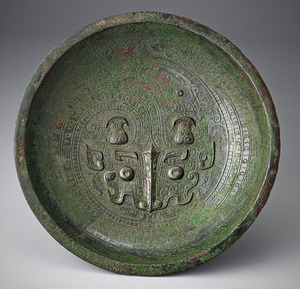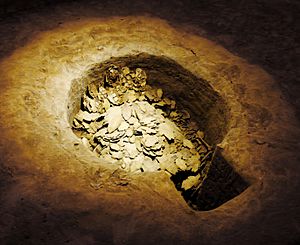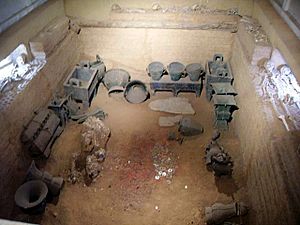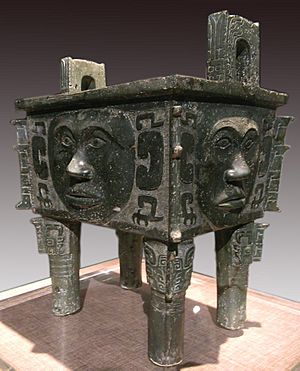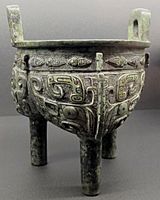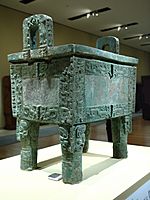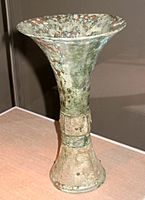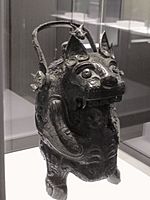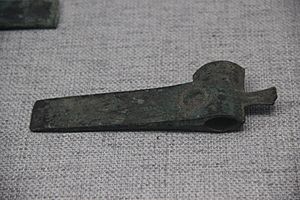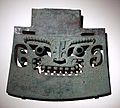Shang Dynasty facts for kids
Quick facts for kids
Shang
|
|||||||||
|---|---|---|---|---|---|---|---|---|---|
| c. 1600 BC– c. 1045 BC | |||||||||
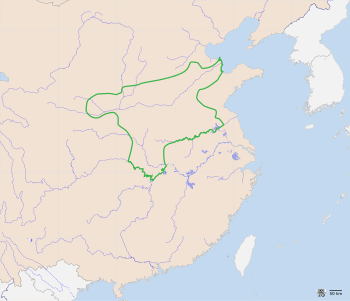
Approximate territory of the Shang dynasty within present-day China
|
|||||||||
| Capital | |||||||||
| Common languages | Old Chinese | ||||||||
| Religion | Chinese patriarchal religion, Divination | ||||||||
| Government | Monarchy | ||||||||
| King | |||||||||
|
• c. 1250 – 1191 BC
|
Wu Ding | ||||||||
|
• c. 1075 – 1046 BC
|
King Zhou | ||||||||
| Legislature | Dynasty | ||||||||
| Historical era | Bronze Age | ||||||||
|
• Established
|
c. 1600 BC | ||||||||
|
• Zhou conquest
|
c. 1045 BC | ||||||||
| Area | |||||||||
| 1122 BC est | 1,250,000 km2 (480,000 sq mi) | ||||||||
| Currency |
|
||||||||
|
|||||||||
| Today part of | China | ||||||||
| Shang | |||||||||||||||||||||||||||||||||||||
|---|---|---|---|---|---|---|---|---|---|---|---|---|---|---|---|---|---|---|---|---|---|---|---|---|---|---|---|---|---|---|---|---|---|---|---|---|---|

"Shang" in oracle bone script (top left), bronze script (top right), seal script (bottom left), and modern regular (bottom right) Chinese characters
|
|||||||||||||||||||||||||||||||||||||
| Chinese | 商 | ||||||||||||||||||||||||||||||||||||
| Hanyu Pinyin | Shāng | ||||||||||||||||||||||||||||||||||||
|
|||||||||||||||||||||||||||||||||||||
| Alternative Chinese name | |||||||||||||||||||||||||||||||||||||
| Chinese | 殷 | ||||||||||||||||||||||||||||||||||||
| Hanyu Pinyin | Yīn | ||||||||||||||||||||||||||||||||||||
|
|||||||||||||||||||||||||||||||||||||
The Shang dynasty (Chinese: 商朝; pinyin: Shāng Cháo), also known as the Yin dynasty (Chinese: 殷代; pinyin: Yīn Dài), was an ancient Chinese kingdom. It was founded by Tang of Shang and ruled in the Yellow River valley. This powerful dynasty existed during the Bronze Age, from about 1600 BC to 1045 BC. It came after the Xia dynasty and was followed by the Western Zhou dynasty.
Historians learned about the Shang dynasty from old texts like the Book of Documents and Records of the Grand Historian. These writings tell us many stories and facts about this important period.
The Shang dynasty is the first Chinese dynasty that archaeologists have found strong evidence for. At a place called the Ruins of Yin, near modern Anyang, archaeologists found many royal tombs and palace foundations. They also found weapons and items from ancient rituals. Thousands of artifacts made of bronze, jade, stone, bone, and ceramic have been discovered there.
The Anyang site is also where the earliest known Chinese writing was found. Most of this writing is on oracle bones, which are turtle shells or ox bones used for divination (predicting the future). These writings tell us a lot about the Shang dynasty's politics, economy, religion, art, and even medicine.
Contents
Stories from Ancient Times
Many stories about the Shang dynasty come from old Chinese books. These include the Book of Documents and the Mencius. A famous historian named Sima Qian wrote a detailed history of the Shang dynasty in his book, Records of the Grand Historian. He described some events in detail, while for other kings, he only listed their names.
The name Yīn (殷) was often used for the dynasty, especially by Sima Qian. It was also used for the last Shang capital. This name has been popular throughout history. However, the Shang people themselves called their state Shāng (商). They called their capital Dàyì Shāng (大邑商), meaning "Great Settlement Shang."
How the Shang Dynasty Began
An old story tells how the Shang dynasty started. A woman named Jiandi swallowed an egg dropped by a black bird. She then miraculously gave birth to a son named Xie. Xie helped a legendary figure named Yu the Great control a big flood. Because of his help, Xie was given a place called Shang.
The Dynasty's Journey
The Records of the Grand Historian says that the Shang dynasty began 13 generations after Xie. Xie's descendant, Tang, overthrew the last ruler of the Xia dynasty in the Battle of Mingtiao. This ruler was said to be very cruel.
The Shang kings moved their capital five times. The last move was to a city called Yin during the reign of Pan Geng. This move marked a very successful period for the dynasty.
Di Xin, the last Shang king, lost his power when his army was defeated by Wu of Zhou. Legends say that his own soldiers and even his enslaved people joined the Zhou rebels in the important Battle of Muye.
After the Shang were defeated, King Wu of Zhou allowed Di Xin's son, Wu Geng, to rule the Shang lands as a smaller kingdom. However, Wu of Zhou sent his brothers and an army to make sure Wu Geng would not rebel. Later, the Shang joined a rebellion against the Zhou, but it failed. This left the Zhou dynasty in full control of the Shang territory.
What Happened to the Shang Royal Family?
After the Shang dynasty fell, the Zhou rulers moved many Shang people to different parts of their territory. Some surviving members of the Shang royal family changed their last name from Zi to Yin (or Shang). They kept an important position in society and often helped the new Zhou dynasty with administration.
One of Di Xin's brothers, Weiziqi, was made the Duke of Song. This family continued to honor the Shang kings until their state was conquered in 286 BC. Some historians believe that Confucius, a very famous Chinese philosopher, might have been a descendant of the Shang kings through the Dukes of Song.
Some Shang clans also moved northeast and became part of the Yan culture. They kept their important status and continued their old traditions of sacrifice and burial.
There are also legends that a Shang prince named Jizi left China with a small army. He supposedly founded a state called Gija Joseon in northwest Korea. However, historians are still discussing if these legends are true.
Discovering the Past: Archaeology
Before the 1900s, the Zhou dynasty was thought to be the earliest Chinese dynasty with clear records. But during the Song dynasty (960–1279 AD), people started finding old bronze vessels from the Shang era. Some of these even had writing on them!
Uncovering the Yellow River Valley
In 1899, scholars noticed that Chinese pharmacists were selling "dragon bones" with strange, old writing. In 1928, these bones were traced back to a site called Yinxu near Anyang. This is north of the Yellow River in modern Henan province. Archaeologists started digging there.
After 1950, the remains of an older walled city were found near Zhengzhou. This city, called Shang City, had huge earth walls built around 1500 BC. These walls were about 20 meters (65 feet) wide at the bottom and 8 meters (26 feet) high. They formed a rectangle about 7 kilometers (4.3 miles) long around the city. Building walls with rammed earth was a very old tradition in China, going back to the Neolithic period.
In 1959, the Erlitou culture site was found near Luoyang. Scientists used radiocarbon dating and found that the Erlitou culture thrived from about 2100 BC to 1800 BC. They built large palaces, which suggests they had an organized government.
In 1983, another large walled city, Yanshi Shang City, was discovered. It dates back to 1600 BC and covered almost 200 hectares (494 acres).
In 1999, the remains of a walled city covering about 470 hectares (1,161 acres) were found near the Yinxu site. This city, called Huanbei, was used for less than a century before Yinxu was built.
Historians used to think that one dynasty simply replaced another. However, the real situation in early China might have been more complex. It's possible that the Xia and Shang dynasties existed at the same time, just as the early Zhou existed alongside the Shang.
How We Know the Dates
The earliest event in Chinese history that we can be sure of is the start of the Gonghe Regency in 841 BC. This date was first set by the historian Sima Qian. Trying to find earlier dates has been tricky because old texts can be hard to understand. More recently, scientists have compared old stories with archaeological finds and even astronomy.
Many different dates have been suggested for when the Shang dynasty ended, ranging from 1130 BC to 1018 BC.
- The traditional dates, from 1766 BC to 1122 BC, were calculated by Liu Xin during the Han dynasty.
- A project called the Xia–Shang–Zhou Chronology Project suggests the dynasty started around 1600 BC. They also believe it ended in 1046 BC, based on astronomy and radiocarbon dating.
- Other studies using radiocarbon dating of oracle bones suggest an end date of 1041 BC.
Life in Late Shang at Anyang
The oldest direct records we have are from about 1250 BC at Anyang. These records cover the time of the last nine Shang kings.
The Shang people had a very advanced writing system. We find it on bronze items and especially on oracle bones. This complex writing shows that it must have developed over a long time. The Shang also made many musical instruments and observed the sky, tracking planets like Mars and various comets.
Their civilization relied on farming, but they also did a lot of hunting and raised animals. Cowry shells found at Anyang suggest they traded with people living near the coast. However, China was quite isolated from other big civilizations during the Shang period.
Life at Court
At the royal palace in Yinxu, archaeologists found large stone bases for pillars. These supported 53 buildings made of wood. Near the main palace, there were underground pits for storage and living quarters for servants.
Many Shang royal tombs were robbed long ago. But in 1976, archaeologists found Tomb 5 at Yinxu. It was untouched and filled with amazing treasures! They found over 200 bronze ritual vessels and 109 items with the name of Lady Fu Hao. She was a famous wife of King Wu Ding and also a respected military general. Her tomb contained bronze weapons, pottery, jade figures, and bone hairpins.
The capital city was the center of court life. The king was not only the ruler but also the head of the ancestor worship religion. He often performed the oracle bone divinations himself. Royal tombs show that kings were buried with valuable items, perhaps for use in the afterlife. Sometimes, hundreds of people were buried with the king, possibly to serve him in the next life.
Shang kings ruled over much of northern China. Their armies often fought with neighboring groups and nomadic people. The king was often worried about the fang, who were groups living outside the Shang territory.
Besides being military commanders, Shang kings were also the high priests. They led divination ceremonies. Oracle bone texts show that Shang kings were seen as the best people to offer sacrifices to their royal ancestors and to the high god Di. Shangdi was believed to control rain, wind, and thunder.
The king appointed officials to manage different activities, like farming, hunting, and guarding. These officials had their own groups of people working for them. There was a basic system of government, with roles like "Many Dog officers" (for hunting) and "Many Artisans." More distant rulers, called marquess or count, sometimes sent gifts and support to the Shang King.
Shang Religion and Beliefs
Shang religious rituals involved divination and sacrifice. They believed their ancestors had power over them. They performed divination rituals to get their ancestors' approval for their plans. This involved cracking a turtle shell or ox bone to answer a question. The answer was then written on the bone. We don't know exactly how they decided the answer, but it might have been based on the sound or pattern of the cracks.
The Shang also seemed to believe in an afterlife. This is clear from the detailed tombs built for their rulers. These tombs often included "carriages, tools, ritual vessels, and weapons." Sometimes, hundreds of people and horses were buried with a king to accompany him into the afterlife. Tombs also had ornaments like jade, which the Shang might have believed would protect against decay or give immortality.
The Shang religion was very organized. Oracle bones recorded the date, ritual, person, ancestor, and questions for each divination. Tombs also showed very organized arrangements of bones.
Amazing Bronze Work
Chinese bronze casting and pottery became very advanced during the Shang dynasty. Bronze was mostly used for important ritual items, not just everyday tools. Around 1500 BC, the early Shang dynasty started making a lot of bronze vessels and weapons. This required many workers for mining, refining, and transporting copper, tin, and lead ores. This also meant there was a need for managers to oversee the workers and skilled artisans.
The Shang royal court and nobles needed many different bronze vessels for ceremonies and religious events. Rules even said how many bronze containers a noble person of a certain rank could own. With more bronze available, the army also got better weapons. Bronze was also used for parts of spoke-wheeled chariots, which appeared in China around 1200 BC.
Shang Military Power
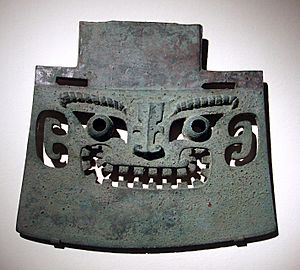
Bronze weapons were very important in Shang society. Shang soldiers used various stone and bronze weapons. These included spears, pole-axes, dagger-axes, composite bows, and bronze or leather helmets.
The chariot first appeared in China around 1200 BC, during the reign of Wu Ding. It is believed that chariots came to China from Central Asia. This suggests some contact with people from the west. Recent discoveries show that the late Shang used horses, chariots, and bows. They also practiced burying horses, similar to steppe peoples. Oracle bone writings suggest that the Shang used chariots in royal hunts and in battles as mobile command vehicles.
Shang rulers could gather large numbers of common people to serve as soldiers. Nobles and other state rulers had to provide their local soldiers with all the necessary equipment and weapons. The Shang king kept about a thousand troops in his capital and would personally lead them into battle. There was also a basic military system to gather forces ranging from three to five thousand troops for border fights to thirteen thousand troops for stopping rebellions.
Who Were the Shang Kings?
The oldest direct records we have are the oracle bones. These bones were written on during the reigns of the Shang kings, starting from Wu Ding. The oracle bones don't have a simple list of kings. However, they do record sacrifices made to previous kings and ancestors. These sacrifices followed a regular schedule. From this, scholars have put together a list of kings and their family tree. This list matches well with later historical accounts, especially for the later kings.
According to this list, Wu Ding was the twenty-first Shang king. The Shang kings were called by special names on the oracle bones. The last part of each name was one of the 10 celestial stems. This also showed the day of the 10-day Shang week when sacrifices would be offered to that ancestor.
Here is a list of the Shang kings, grouped by generation, based on the oracle bones:
| Generation | Older brothers | Main line of descent | Younger brothers | Divination phase | ||
|---|---|---|---|---|---|---|
| 1 | Da Yi (大乙) | |||||
| 2 | Da Ding (大丁) | |||||
| 3 | Da Jia (大甲) | Bu Bing (卜丙) | ||||
| 4 | Da Geng (大庚) | Xiao Jia (小甲) | ||||
| 5 | Da Wu (大戊) | Lü Ji (呂己) | ||||
| 6 | Zhong Ding (中丁) | Bu Ren (卜壬) | ||||
| 7 | Jian Jia (戔甲) | Zu Yi (祖乙) | ||||
| 8 | Zu Xin (祖辛) | Qiang Jia (羌甲) | ||||
| 9 | Zu Ding (祖丁) | Nan Geng (南庚) | ||||
| 10 | Xiang Jia (象甲) | Pan Geng (盤庚) | Xiao Xin (小辛) | Xiao Yi (小乙) | ||
| 11 | Wu Ding (武丁) | 1254-1197 BC (I) | ||||
| 12 | Zu Geng (祖庚) | Zu Jia (祖甲) | 1206-1177 BC (II) | |||
| 13 | Lin Xin (廩辛) | Geng Ding (康丁) | 1187-1135 BC (III) | |||
| 14 | Wu Yi (武乙) | 1157–1110 BC (IV) | ||||
| 15 | Wen Wu Ding (文武丁) | |||||
| 16 | Di Yi (帝乙) | 1121–1041 BC (V) | ||||
| 17 | Di Xin (帝辛) | |||||
Images for kids
See also
 In Spanish: Dinastía Shang para niños
In Spanish: Dinastía Shang para niños



